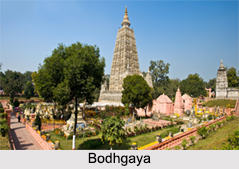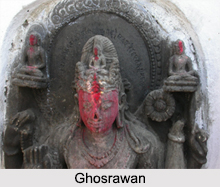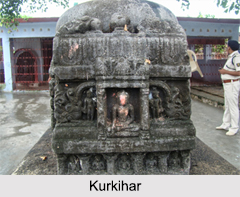 Monasteries in Bihar are now popular tourism destinations. As Bihar is an ancient civilized state and the capital of ancient India, Bihar possesses many monasteries, temples and mosques. Buddhism came in Bihar with the hands of Gautama Buddha and the patronage of Maurya Empire.
Monasteries in Bihar are now popular tourism destinations. As Bihar is an ancient civilized state and the capital of ancient India, Bihar possesses many monasteries, temples and mosques. Buddhism came in Bihar with the hands of Gautama Buddha and the patronage of Maurya Empire.
Bodhgaya, Gaya District
Bodh Gaya is located in the Eastern part of Bihar in Gaya District. It was the place where Buddha in pursuit of the real meaning of life beyond any pain and suffering finally gained enlightenment under the Banyan Tree - now known and revered as Bodhi Tree. Bodh Gaya is the most important of the main four pilgrimage sites related to the life of Gautama Buddha, the other three being Kushinagar, Lumbini, and Sarnath in Uttar Pradesh.
Prag Bodhi, Dungeswari Hills
Prag Bodhi is the site where Gautama Buddha practiced austerities in order to find the awakening and the solution of life from pain and suffering. It is located on the top of Dungeswari Hills. The site has several ancient stupas along with a small Tibetan Buddhist temple.
Barabar Caves, Sultanpur
The oldest surviving rock cut caves in India after the Bhimbetka Cave is Barbar Caves. Barabar Caves is located on the twin hills of Barabar and Nagarjuni. It was carved in the Mauryan times; the caves have larger Buddhist Chaitya including stupa emblems, elephant engravings, circular vaulted chambers with rectangular mandapa and a curved architrave.
Champanagar, Bhagalpur District
 Champanagar is located in Bhagalpur district in Bihar. This place is visited by Lord Buddha many times. Also, the site witnessed some of the important discourses and sermons from Lord Buddha including Kandaraka Sutta, Sonadanda Sutta, etc.
Champanagar is located in Bhagalpur district in Bihar. This place is visited by Lord Buddha many times. Also, the site witnessed some of the important discourses and sermons from Lord Buddha including Kandaraka Sutta, Sonadanda Sutta, etc.
Gaggara`s Lotus Lake, Bhagalpur District
One of the prime attractions of Champanagar is a tank known as Gaggara`s Lotus Lake where lotuses bloom. It is the part of the monastery of Champanagar. On the banks of the lake is a grove of huge Champaka trees, which is believed to be the most favored spot of Gautama Buddha.
Sarovana Talab
Sarovana Talab is now a lake. Hundred of statues of Gautama Buddha were excavated here when the lake was cleaned.
Dona Stupa
Dona Stupa is one of the important monasteries in Bihar. After Buddha"s Parinirvana and cremation, a dispute ensued between the four Buddha disciples over the division of his mortal ashes. Eventually the task of fair division of the ashes was ensued to a Brahmin named Dona. He divided the ashes into eight equal halves for the claimants. The disciples then satisfied by his fairness presented him the vessel in which the ashes had been stored. The stupa at Dona enshrines the very same holy vessel which is now reduced to a grassy mound. A Hindu temple is built over the mound where the idol of goddess Tara is worshipped.
Ghosrawan
Ghosrawan was once a very large and elaborate Buddhist Vihara in early India. It presently contains the relics of the same. To enshrine the presence of Lord Buddha in the area, the 10 feet statue black stone statue of meditating Gautama Buddha is carved. Few kilometers towards the south Ghosrawan is Tetravan, where a temple showcases an extensive collection of Buddhas and Bodhisattvas.
Bihar Gurpa, 33 km from Gaya
Bihar Gurpa enshrines the abode of Mahakassapa, the successor of Lord Buddha who is still believed to be waiting for the arrival of Maitreya, the future Buddha. 
Hajipur
Hajipur is a prominent Buddhist site as it enshrines the mortal remains of Ananda, the very wise and closest disciple of Lord Buddha. He also served as the attendant of Gautama Buddha for 20 years.
Indasala Cave
Indasala Cave in Bihar witnessed a number of sermons and discourses from Lord Buddha himself including Sakkapanha Sutta and Dhammapada.
Kesaria Stupa
The biggest Buddhist stupa at Kesariya has been deeply associated with Lord Buddha who once stayed there and preached the Sutta to the disciples.
Nalanda
Nalanda was one of the first great Buddhist learning centers in ancient India. This University attracted many scholars and students from far away China, Greece, and Persia. Around 2,000 teachers and 10,000 monk students from all over the world lived and studied here. Buddha himself visited the university many times.
Rajgir
Rajgir has witnessed several episodes of Buddha"s life. Here only Lord Buddha preached various sermons, proselytized Emperor Bimbisar at the Griddhakoota - Vulture Hill and meditated many times.






